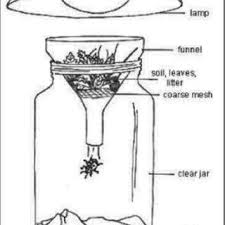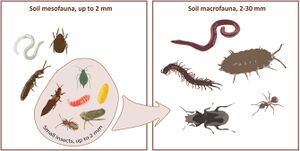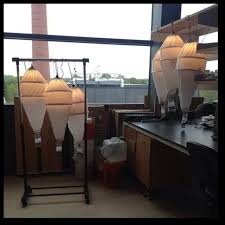Berlese tullgren funnel: Difference between revisions
| Line 1: | Line 1: | ||
==Overview== | ==Overview== | ||
Berlese-Tullgren Funnels, also known and Berlese funnels or Tullgren funnels, are used to extract [[arthropods]] from [[soil]]. [[Mesofauna]] and [[macrofauna]] are the target size for a Berlese-Tullgren funnel, focusing on arthropods. The funnel works on the basis that arthropods will turn away from direct light. The Berlese-Tullgren funnel works to force them into a container through a funnel of a soil sample using heat and light. <ref> “Berlese Funnels - Collecting Methods - Mississippi Entomological Museum Home.” Mississippi Entomological Museum, https://mississippientomologicalmuseum.org.msstate.edu/collecting.preparation.methods/Berlesefunnel.htm. Accessed 30 April 2025. </ref> [[File:tullgren_funnel.jpg|thumb|border| | Berlese-Tullgren Funnels, also known and Berlese funnels or Tullgren funnels, are used to extract [[arthropods]] from [[soil]]. [[Mesofauna]] and [[macrofauna]] are the target size for a Berlese-Tullgren funnel, focusing on arthropods. The funnel works on the basis that arthropods will turn away from direct light. The Berlese-Tullgren funnel works to force them into a container through a funnel of a soil sample using heat and light. <ref> “Berlese Funnels - Collecting Methods - Mississippi Entomological Museum Home.” Mississippi Entomological Museum, https://mississippientomologicalmuseum.org.msstate.edu/collecting.preparation.methods/Berlesefunnel.htm. Accessed 30 April 2025. </ref> [[File:tullgren_funnel.jpg|thumb|border|left|Sketch of a Berlese-Tullgren funnel]] [[File:Soil_Mesofauna.jpg|thumbnail|right|Mesofauna and Macrofauna]] | ||
The funnel method is non-specific and you will catch many different species of different sizes. | The funnel method is non-specific and you will catch many different species of different sizes. | ||
The fault of the Berlese-Tullgren funnel is that high mortality rates tend to occur due to the direct heat and slow movements of the arthropods. however, the funnel is much faster and more efficient than other methods such as the Winkler Extractor. <ref> “Invertebrate Capture Techniques - Chapter 6.” Consult-Eco, https://stevemcwilliam.co.uk/entomol/invcapt6.htm. Accessed 30 April 2025.</ref> | The fault of the Berlese-Tullgren funnel is that high mortality rates tend to occur due to the direct heat and slow movements of the arthropods. however, the funnel is much faster and more efficient than other methods such as the Winkler Extractor. <ref> “Invertebrate Capture Techniques - Chapter 6.” Consult-Eco, https://stevemcwilliam.co.uk/entomol/invcapt6.htm. Accessed 30 April 2025.</ref> | ||
| Line 11: | Line 11: | ||
===Composition=== | ===Composition=== | ||
The funnel is composed of a container, a funnel, a fine mesh lining, a light source and your soil sample. | The funnel is composed of a container, a funnel, a fine mesh lining, a light source and your soil sample. | ||
There are many ways to alternatively make a Berlese Tullgren Funnel as long as the general composition and idea are there. Some funnels have the catchings fall into a pool of alcohol. | There are many ways to alternatively make a Berlese Tullgren Funnel as long as the general composition and idea are there. Some funnels have the catchings fall into a pool of alcohol. | ||
==References== | ==References== | ||
<references /> | <references /> | ||
Revision as of 09:27, 30 April 2025
Overview
Berlese-Tullgren Funnels, also known and Berlese funnels or Tullgren funnels, are used to extract arthropods from soil. Mesofauna and macrofauna are the target size for a Berlese-Tullgren funnel, focusing on arthropods. The funnel works on the basis that arthropods will turn away from direct light. The Berlese-Tullgren funnel works to force them into a container through a funnel of a soil sample using heat and light. [1]


The funnel method is non-specific and you will catch many different species of different sizes. The fault of the Berlese-Tullgren funnel is that high mortality rates tend to occur due to the direct heat and slow movements of the arthropods. however, the funnel is much faster and more efficient than other methods such as the Winkler Extractor. [2]
History
The funnel was first described by Italian entomologist, Antonio Berlese.He formed the idea by surrounding a metal funnel in a water jacket heated by a bunsen burner. The heat from the water drove the arthropods down the funnel into a collection tube. This was later developed by arachnologist Albert Tullgren who decided to use an electric lamp to heat the surface of the soil.
This allowed more time for the insects to reach the collection tube before drying out and dying. [3]

Both Berlese funnel and Tullgren funnel are generally interchangable terms, Berlese-Tullgren funnel represents the most modern technique used for research, which is a combination of the two.
Composition
The funnel is composed of a container, a funnel, a fine mesh lining, a light source and your soil sample. There are many ways to alternatively make a Berlese Tullgren Funnel as long as the general composition and idea are there. Some funnels have the catchings fall into a pool of alcohol.
References
- ↑ “Berlese Funnels - Collecting Methods - Mississippi Entomological Museum Home.” Mississippi Entomological Museum, https://mississippientomologicalmuseum.org.msstate.edu/collecting.preparation.methods/Berlesefunnel.htm. Accessed 30 April 2025.
- ↑ “Invertebrate Capture Techniques - Chapter 6.” Consult-Eco, https://stevemcwilliam.co.uk/entomol/invcapt6.htm. Accessed 30 April 2025.
- ↑ “Entomological classics – The Tullgren (Berlese) Funnel | Don't Forget the Roundabouts.” Don't Forget the Roundabouts, 3 May 2016, https://simonleather.wordpress.com/2016/05/03/entomological-classics-the-tullgren-berlese-funnel/. Accessed 30 April 2025.